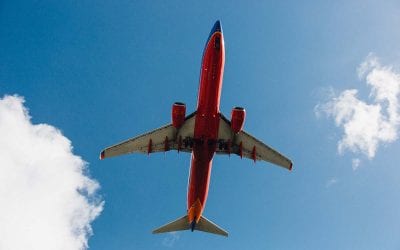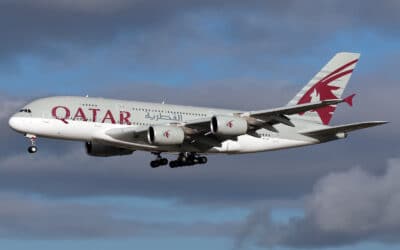These 15 rules of what not to do with checked luggage can prevent checked luggage problems if you follow them.
 I had dinner with a friend recently who told me that on a recent trip to Des Moines, when he checked his bag, he grabbed his receipt and stuffed it into his wallet without looking at it. He also never looked at the bar coded luggage tag the airline’s agent put on his bag.
I had dinner with a friend recently who told me that on a recent trip to Des Moines, when he checked his bag, he grabbed his receipt and stuffed it into his wallet without looking at it. He also never looked at the bar coded luggage tag the airline’s agent put on his bag.
He didn’t follow my first checked luggage rule, to always check the airline luggage tag before it’s affixed to your luggage. That’s to ensure it’s going to the correct airport.
Carefully check your airline’s luggage tag to make sure your bag is going on the same flight as you’re on.
When he arrived at his destination, his luggage wasn’t there. It was on its way to Hawaii. The airline returned his checked bag to him the day after he returned home.
I’ve got 15 rules of what not do with your checked luggage:
15. Locking your bag with a lock that’s not TSA approved:
If your checked luggage lock isn’t TSA approved and TSA decides to hand-check your bag, they will break the lock and that might damage your luggage. I use plastic, one-use, numbered seals on my checked luggage, especially if traveling internationally.
Don’t pack loose Li-Ion batteries in your checked luggage or any other prohibited items.
14. Packing loose Lithium-Ion batteries in your checked luggage:
While it’s okay to pack loose Lithium-Ion (Li-Ion) batteries, such as those used in cameras and other electronic gear in your carry-on, they’re not allowed in checked luggage. Because they’re a fire hazard, they’re prohibited in checked luggage by the Federal Aviation Administration.
13. Packing any prohibited item in your checked bag:
You don’t want to pack prohibited items of any kind in your luggage, including your checked bag. Like carry-ons, checked bags are x-rayed. You don’t want airport security digging into your bag if you can avoid it. The one time that I know TSA went into my checked luggage for a suspicious item, nothing was taken from the bag, but there were hand prints and stains on my belongings. If time is tight, it’s possible hand-checking your bag for a prohibited item could prevent it from getting to your flight.
Don’t pack all of your clothes in your checked luggage and protect the ones packed there from any leaking bottles.

I pack at least one complete change of clothes in my carry-on, two if it will fit with the other necessary items there. That way, if my checked bag doesn’t make it to my destination on time, I’m covered for at least a day or two.
11. Not protecting your checked bag against leaky bottles:
Particularly on a longer trip, many pack larger containers of toiletries to last for their entire journey in their checked luggage. It’s important to protect your belongings in the bag in case your liquid toiletries leak. I pack mine in a well sealed dry bag. It’s saved me several times.
10. Not weighing your checked bag before leaving home and packing it too close to the airline weight limit:
Checked luggage has a weight limit when you fly on any scheduled commercial airline. Flying with an overweight bag can be expensive. At American Airlines, for example, if you’re just 1–3 pounds overweight it will cost $30. If you’re more than three pounds overweight, it will cost an extra $100 or more. Weigh your bag at home to avoid overweight fees and don’t pack it so close to the limit that the airport scale might say it’s overweight.
Pack your medications, breakables and valuables in your carry-on, not your checked bag. Leave anything you can’t afford to lose at home.
9. Packing your medications in your checked bag:
Medications, particularly many prescription medications can be difficult to replace while traveling domestically and impossible to replace when traveling internationally. Don’t take a chance with your medications, even the over-the-counter ones. Pack them in your carry-on.
8. Packing breakables and valuables, including laptops, in your checked bag:
All breakables and valuables should be packed in your carry-on which is in your possession and under your control. Your checked bag can be seriously delayed, lost or damaged. If lost or damaged, airlines deny liability for breakables and valuables, so you will not be reimbursed for their loss or damage in your checked bag.
7. Packing anything you can’t afford to lose in your checked bag:
Frankly, if you can’t afford to lose it, you should leave it at home, but if you really can’t leave it, even when you know you should, put it in your carry-on so it’s under your control at all times. Never put a belonging you can’t afford to lose in checked luggage.
Use a tracking device in your checked luggage for piece of mind and to find it if lost.
6. Not using a tracking device in your checked bag:
Personally, I use Apple AirTags in all my luggage. At the least, after my plane leaves the gate, I get peace of mind when my iPhone tells me that my bags are moving with me and therefore on my flight. At the worst, it can help me find my bag and help the airline see where it is so it can be returned quickly.
Make sure your bag is identifiable with personalization and multiple IDs.
5. Not personalizing your checked bag:
Unless your checked bag is very unusual there will be multiple checked bags on your flight that look very similar to yours, particularly if your bag is “basic black.” I use a heavy duty, bright blue elastic strap around my bag and I have a heavy-duty ribbon on the top handle. Make your bag highly recognizable. You stop others from thinking your bag is theirs, help you see if someone is walking away with your bag and help you see your bag on the carousel to grab it before someone else does.
4. Not having multiple ID tags on your checked bag:
Every checked bag should have at least two ID tags on it. Put one on the top handle and one on the side handle. I often see bags in the luggage carousel with no identification on them, as the ID tag was knocked off during luggage handling. I’ve had a couple of flights over the last five years on which one of my ID tags was knocked off, along with the airline’s tag being partial torn.
3. Use flimsy luggage:
No one has to purchase expensive luggage to happily travel. But don’t buy a bag that’s so inexpensive that it can’t hold up against the rough treatment that checked bags endure during luggage handling at the airport throughout your journey.
Retain proof that you checked a bag on your flight and be sure to check the airline luggage tag to ensure it’s going to your destination.
2. Not retaining proof that you checked a bag:
Fortunately, my friend held on to his receipt. That did two critical things for him. It proved he had checked his bag so he could get compensation if the bag was damaged or never recovered. It also helped the airline get his bag back to him quickly.
1. Not checking that the airline luggage tag is for the right destination airport:
Don’t be like my friend who didn’t get his checked bag returned after traveling to the wrong airport until he was home. He had to buy a new suit for his wardrobe, some shirts, etc.

After many years working in corporate America as a chemical engineer, executive and eventually CFO of a multinational manufacturer, Ned founded a tech consulting company and later restarted NSL Photography, his photography business. Before entering the corporate world, Ned worked as a Public Health Engineer for the Philadelphia Department of Public Health. As a well known corporate, travel and wildlife photographer, Ned travels the world writing about travel and photography, as well as running photography workshops, seminars and photowalks. Visit Ned’s Photography Blog and Galleries.



